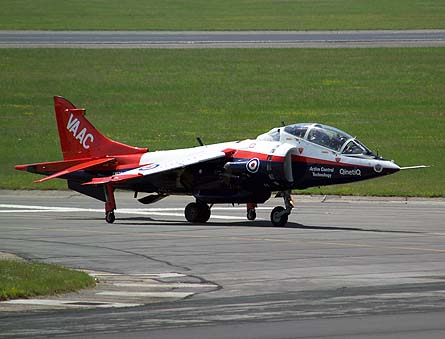By Craig Hoyle in Bedford
UK flight-test activities in support of the F-35B short take-off and vertical landing (STOVL) version of Lockheed Martin's Joint Strike Fighter (JSF) have resumed using a Qinetiq-modified British Aerospace Harrier featuring modified flight controls.
Continuing a series of trials launched in 1999, the current activity started at the joint UK Ministry of Defence/Qinetiq Aircraft Test and Evaluation Centre at Boscombe Down in Wiltshire on 28 June.
Scheduled to continue until the second quarter of next year, the flights will use Qinetiq's VAAC Harrier trials aircraft to further de-risk future flight testing of the STOVL F-35B in the USA from early 2008. Expected to remain in operational use until mid-2008, the company-owned aircraft could also be made available for use by programme test pilots ahead of flying the JSF, it says.
|
|---|
| The VAAC aircraft has supported JSF development since 1999 |
Flight International was invited late last month to fly Qinetiq's dynamic simulator for the VAAC Harrier at the company's Bedford site in Bedfordshire in the so-called unified control mode that will be used with production F-35Bs for the US Marine Corps and the UK Royal Air Force and Royal Navy.
The device replicates the test aircraft's rear cockpit, which has been modified to include new controls representative of the JSF. Future F-35B pilots will use two "inceptors" to control the aircraft: a left-hand linear throttle to manage forward and rearward velocity; and a right-hand sidestick for vertical and lateral control.
"There are a factor of 10 more accidents in take-off and landing with the Harrier versus the [Sepecat] Jaguar and [Panavia] Tornado," says Qinetiq's development test pilot Justin Paines. "We are trying to simplify the piloting task as much as possible."
Paines says the latest phase of flight trials is intended to fine-tune handling qualities from earlier elements of the VAAC project, and to address other "loose ends" from previous development work. The MoD's test pilot community at Boscombe Down is also supporting the work, providing two safety pilots - one RAF and one RN - to fly the aircraft from the front seat using either traditional Harrier controls or the new unified configuration.
The previous phase of VAAC flights culminated with 101 deck landings aboard the RN aircraft carrier HMS Invincible in May 2005, demonstrating the aircraft's ability to automatically return to and land aboard the vessel with centimetric accuracy.
Source: Flight International

















